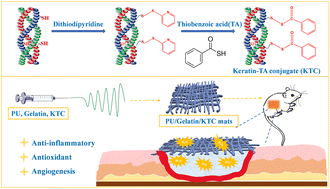Hydrogen sulfide-releasing polyurethane/gelatin/keratin–TA conjugate mats for wound healing†
Abstract
Hydrogen sulfide (H2S) has indispensable effects on wound healing promotion, such as anti-inflammatory, cell proliferation enhancement, and angiogenesis improvement. However, small-molecular donors have drawbacks of burst release and low biocompatibility. In this study, a novel bio-macromolecular donor of H2S based on a keratin–thiobenzoic acid conjugate (KTC) was first synthesized by a thiol–disulfide exchange reaction. Then, the KTC was incorporated into polyurethane and gelatin to fabricate nanofibrous mats by electrospinning. Interestingly, both the KTC donor and biocomposite mats were capable of releasing H2S triggered by glutathione (GSH) under physiological conditions. These mats had excellent water absorption capacity, demonstrating their great ability to absorb tissue exudate. In addition, these mats possessed a notable antioxidant ability, thereby protecting cell membranes from oxidation. Cell assays in vitro demonstrated that these mats could promote cell proliferation and migration. Furthermore, the in vivo full-thickness defect model verified that these H2S-releasing wound dressing mats could accelerate granulation tissue formation, enhance collagen deposition, and promote angiogenesis. Based on these advantages, these wound dressing mats had great potential applications for wound healing.

- This article is part of the themed collection: Journal of Materials Chemistry B HOT Papers


 Please wait while we load your content...
Please wait while we load your content...